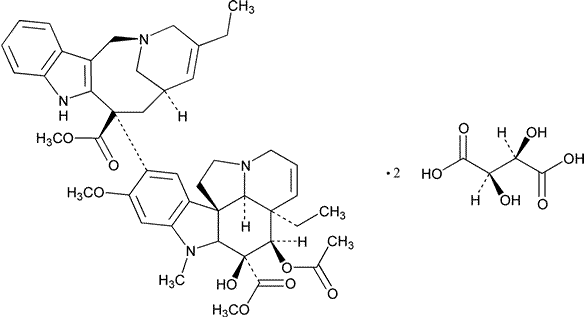Vinorelbine Tartrate
»Vinorelbine Tartrate contains not less than 98.0percent and not more than 102.0percent of C45H54N4O8·2C4H6O6,calculated on the anhydrous basis.
Caution—Vinorelbine Tartrate is cytotoxic.Great care should be taken to prevent inhaling particles and exposing the skin to it.
Packaging and storage—
Preserve in tight,light-resistant containers.Store in a freezer.
Clarity of solution—
Dissolve an amount of Vinorelbine Tartrate,equivalent to 100.0mg of anhydrous vinorelbine,in 10mLof water:the solution is clear.
Color of solution—
The absorbance of the solution prepared under Clarity of solution,determined in a 1-cm cell at 420nm in a suitable spectrophotometer,using water as the blank,is not more than 0.03.
Identification—
A:
Infrared Absorption á197Kñ—
Test specimen—
Dissolve 10mg in 5mLof water,add 0.5mLof 5Nsodium hydroxide,and extract with 5mLof methylene chloride.Filter the organic extract through anhydrous sodium sulfate,and evaporate the organic extract to a volume of about 0.5mL.
B:
The retention time of the major peak in the chromatogram of the Test solutioncorresponds to that in the chromatogram of the Diluted standard solution,as obtained in the test for Related compounds.
C:
To 0.1mLof a solution containing the equivalent of about 15mg of tartaric acid per mL,add 0.1mLof a 100g per Lsolution of potassium bromide,0.1mLof a 20g per liter solution of resorcinol,and 3mLof sulfuric acid.Heat on a hot water bath for 5to 10minutes until a dark blue color develops.Allow to cool,and pour the solution into water.The color changes to red (presence of tartrate).
pHá791ñ:
between 3.3and 3.8,in a solution (10mg per mL).
Water,Method Ia á921ñ:
not more than 4.0%.
Residue on ignition á281ñ:
not more than 0.1%.
Related compounds—
Phosphate buffer—
Dissolve 6.9g of monobasic sodium phosphate in 900mLof water.Adjust with phosphoric acid to a pHof 4.2,dilute with water to 1000mL,and mix.
Mobile phase—
Dissolve 1.22g of sodium 1-decanesulfonate in 620mLof methanol.Add 380mLof Phosphate buffer,mix,filter,and degas.Make adjustments if necessary (see System Suitabilityunder Chromatography á621ñ).
System suitability solution—
Dissolve accurately weighed quantities of USP Vinorelbine Tartrate RSand USP Vinorelbine Related Compound A RSin water,and dilute quantitatively,and stepwise if necessary,with water to obtain a solution having known concentrations of about 1.4mg per mLand 0.01mg per mL,respectively.Expose a portion of this solution in a suitable xenon lamp apparatus capable of supplying a dose of 1600KJ/m2between 310and 800nm at a power of 500W/m2for about one hour,in order to generate an additional degradation product (3¢,4¢,7,8-tetradehydro-3,4¢-dideoxy-3,6-epoxy-6,7-dihydro-C¢-norvincaleukoblastine)having a relative retention time of about 0.8.
Standard solution—
Dissolve an accurately weighed quantity of USP Vinorelbine Tartrate RSin Mobile phase,and dilute quantitatively,and stepwise if necessary,with Mobile phaseto obtain a solution having a known concentration of about 1.4mg per mL.
Diluted standard solution—
Transfer 1.0mLof the Standard solutionto a 50-mLvolumetric flask,and dilute with Mobile phaseto volume.Pipet 1.0mLof this solution into a 100-mLvolumetric flask,and dilute with Mobile phaseto volume.
Test solution—
Transfer about 35mg of Vinorelbine Tartrate,accurately weighed,to a 25-mLvolumetric flask,dissolve in and dilute with Mobile phaseto volume,and mix.
Chromatographic system (see Chromatography á621ñ)—
The liquid chromatograph is equipped with a 267-nm detector and a 3.9-mm ×15-cm column that contains 5-µm packing L1.The column temperature is maintained at 40 .The flow rate is about 1.0mLper minute.Chromatograph the System suitability solution,and record the peak responses as directed for Procedure:the retention time for vinorelbine is about 13.5minutes;and the relative retention times are about 0.8for the photodegradation product,1.0for vinorelbine,and 1.2for vinorelbine related compound A.The relative retention,a,between vinorelbine tartrate and vinorelbine related compound Ais not less than 1.1.
.The flow rate is about 1.0mLper minute.Chromatograph the System suitability solution,and record the peak responses as directed for Procedure:the retention time for vinorelbine is about 13.5minutes;and the relative retention times are about 0.8for the photodegradation product,1.0for vinorelbine,and 1.2for vinorelbine related compound A.The relative retention,a,between vinorelbine tartrate and vinorelbine related compound Ais not less than 1.1.
Procedure—
Separately inject equal volumes (about 20µL)of the Test solutionand the Diluted standard solutioninto the chromatograph,record the chromatograms,and measure the areas for the major peaks.Record the chromatograms for three times the retention time of the vinorelbine peak.Disregard any peaks with an area less than or equal to one-half of the area of the peak obtained for vinorelbine in the Diluted standard solution.Calculate the percentage of each impurity in the portion of Vinorelbine Tartrate taken by the formula:
100(ri/rs),
in which riis the peak response for each impurity obtained from the Test solution;and rsis the sum of the responses of all the peaks:not more than 0.3%of the photodegradation product is found;not more than 0.2%of any individual impurity or coeluted impurities comprising an individual peak is found;and not more than 0.7%of total impurities,excluding the photodegradation product,is found.
Assay—
Dissolve about 350mg of Vinorelbine Tartrate,accurately weighed,in 40.0mLof glacial acetic acid.Titrate with 0.1Nperchloric acid VS,determining the endpoint potentiometrically,using suitable electrodes.Perform a blank determination,and make any necessary correction (see Titrimetry á541ñ).Each mLof 0.1Nperchloric acid is equivalent to 53.96mg of C45H54N4O8·2C4H6O6.
Auxiliary Information—
Staff Liaison:Lawrence Evans,III,Ph.D.,Scientist
Expert Committee:(PA6)Pharmaceutical Analysis 6
USP28–NF23Page 2027
Pharmacopeial Forum:Volume No.27(5)Page 3054
Phone Number:1-301-816-8389
